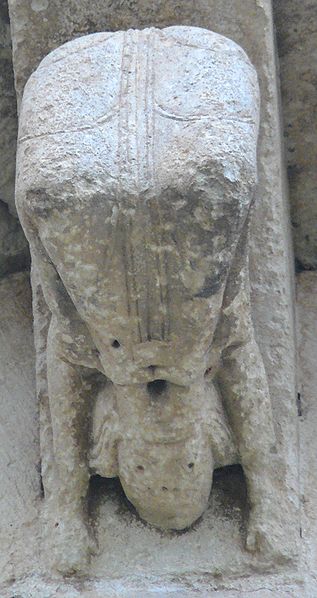In the Middle Ages, professional musicians and minstrels were highly thought of and ranked in royal and noble households as the equals to huntsmen and falconers. Dancers, too, were well regarded - in 1306, the only woman paid as a musician in the royal household was an acrobatic dancer (saltatrix, 'tumbler') with the 'stage name’ of Matilda Makejoy. She possibly danced by bending backwards and touching her head with her feet, or on her hands, or on knives - in medieval stained glass Salome was shown dancing on knives.
Such dancers could be athletic and graceful or tumble in a jesting manner, playing for laughter. They could also be well paid and respected - Richard II paid John Katerine, a dancer from Venice, over £6 for playing and dancing before him, a sum not far short of £3,000 today.
Amongst the minstrels themselves there was a kind of ranking, with professional musicians at the top and jugglers and puppeteers at the bottom. Jugglers especially were considered at the time to be coarse, especially those who made a living wandering from fair to fair or village to village. Jugglers were felt to have few morals and to be able to do their tricks through magic - always a dangerous idea in the Middle Ages.
However jugglers were also held in affection, even by the church, and many illuminated manuscripts show jugglers. From the time of William the Conqueror, a 'King of the Jugglers' appeared at the court and would continue to appear through the Middle Ages. Whoever held this title had many rights to go with it. There is also a medieval legend of a juggler who, having nothing else to give, made an 'offering' of his juggling skills before a statue of the Virgin and Child in church. According to some variations of this story, the Madonna or Jesus caught one of the balls.
Juggling using different objects is more difficult than using the same objects. Bouncing objects off a floor is easier than tossing them in the air, and throwing all the objects in the air - called multiplexing in modern juggling - is easier than one after another.
Balls were commonly used for juggling but other things could also be used. In the Irish story of Cuchulainn, the hero juggles nine apples. The later Viking sagas also mention juggling and sometimes with weapons - Snorri Sturluson writes in one saga, "In the doorway of the hall, Gylfi saw a man juggling with knives, keeping seven in the air at a time.", a trick also mastered by Sunniva in "A Knight's Captive"
Geraint, my Welsh hero, is a tumbler and juggler. To read more about him and the medieval exorcist Yolande, please take a look at "Dark Maiden"
[Illustrations from Wikimedia Commons.]

Such dancers could be athletic and graceful or tumble in a jesting manner, playing for laughter. They could also be well paid and respected - Richard II paid John Katerine, a dancer from Venice, over £6 for playing and dancing before him, a sum not far short of £3,000 today.
Amongst the minstrels themselves there was a kind of ranking, with professional musicians at the top and jugglers and puppeteers at the bottom. Jugglers especially were considered at the time to be coarse, especially those who made a living wandering from fair to fair or village to village. Jugglers were felt to have few morals and to be able to do their tricks through magic - always a dangerous idea in the Middle Ages.
However jugglers were also held in affection, even by the church, and many illuminated manuscripts show jugglers. From the time of William the Conqueror, a 'King of the Jugglers' appeared at the court and would continue to appear through the Middle Ages. Whoever held this title had many rights to go with it. There is also a medieval legend of a juggler who, having nothing else to give, made an 'offering' of his juggling skills before a statue of the Virgin and Child in church. According to some variations of this story, the Madonna or Jesus caught one of the balls.
Juggling using different objects is more difficult than using the same objects. Bouncing objects off a floor is easier than tossing them in the air, and throwing all the objects in the air - called multiplexing in modern juggling - is easier than one after another.
Balls were commonly used for juggling but other things could also be used. In the Irish story of Cuchulainn, the hero juggles nine apples. The later Viking sagas also mention juggling and sometimes with weapons - Snorri Sturluson writes in one saga, "In the doorway of the hall, Gylfi saw a man juggling with knives, keeping seven in the air at a time.", a trick also mastered by Sunniva in "A Knight's Captive"
Geraint, my Welsh hero, is a tumbler and juggler. To read more about him and the medieval exorcist Yolande, please take a look at "Dark Maiden"
[Illustrations from Wikimedia Commons.]







 Welcome to my main blog, where you can find out all about my books.
Welcome to my main blog, where you can find out all about my books.
2 comments:
Lindsay, absolutely fascinating! And your heroine, Sunniva, mastering that juggling trick, now that's impressive.
Thanks, Savanna - I had great fun writing that scene.
Post a Comment